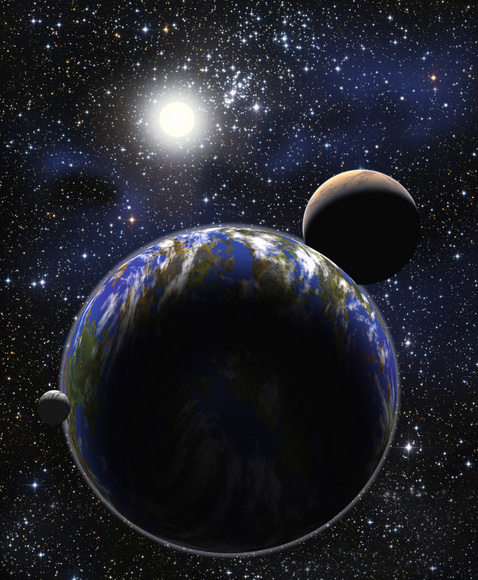
Artist's rendering of a hypothetical world with two moons that could be detected using new laser technology called the "astro-comb." Credit: David A. Aguilar (CfA)
As the race ramps up to find Earth-like planets around other stars, lasers are a viable option.
That according to researchers at the Harvard-Smithsonian Center for Astrophysics in Cambridge, Massachusetts, who have created an “astro-comb,” a sort of calibration tool based on wavelengths of light, to pick up minute variations in a star’s motion caused by orbiting planets.
In most cases, extrasolar planets can’t be seen directly—the glare of the nearby star is too great—but their influence can be discerned through spectroscopy, which analyzes the energy spectrum of the light coming from the star. Not only does spectroscopy reveal the identity of the atoms in the star (each element emits light at a certain characteristic frequency), it can also tell researchers how fast the star is moving away or toward Earth, courtesy of the Doppler effect, which occurs whenever a source of waves is itself in motion. By recording the change in the frequency of the waves coming from or bouncing off of an object, scientists can deduce the velocity of the object.
Though the planet might weigh millions of times less than the star, the star will be jerked around a tiny amount owing to the gravity interaction between star and planet. This jerking motion causes the star to move toward or away from Earth slightly in a way that depends on the planet’s mass and its nearness to the star. The better the spectroscopy used in this whole process, the better will be the identification of the planet in the first place and the better will be the determination of planetary properties.
Right now standard spectroscopy techniques can determine star movements to within a few meters per second. In tests, the Harvard researchers are now able to calculate star velocity shifts of less than 1 m (3.28 feet) per second, allowing them to more accurately pinpoint the planet’s location.
Smithsonian researcher David Phillips says that he and his colleagues expect to achieve even higher velocity resolution, which when applied to the activities of large telescopes presently under construction, would open new possibilities in astronomy and astrophysics, including simpler detection of more Earth-like planets.
With this new approach, Harvard astronomers achieve their great improvement using a frequency comb as the basis for the astro-comb. A special laser system is used to emit light not at a single energy but a series of energies (or frequencies), evenly spaced across a wide range of values. A plot of these narrowly-confined energy components would look like the teeth of a comb, hence the name frequency comb. The energy of these comb-like laser pulses is known so well that they can be used to calibrate the energy of light coming in from the distant star. In effect, the frequency comb approach sharpens the spectroscopy process. The resultant astro-comb should enable a further expansion of extrasolar planetary detection.
The astro-comb method has been tried out on a medium-sized telescope in Arizona and will soon be installed on the much larger William Herschel Telescope, which resides on a mountaintop in the Canary Islands.
Preliminary results from the new technique were published in the April 3, 2008 issue of Nature. The Harvard group will present the most recent findings at the 2009 Conference on Lasers and Electro Optics/International Quantum Electronics Conference, May 31 to June 5 in Baltimore.
Source: Eurekalert



0 comments:
Post a Comment